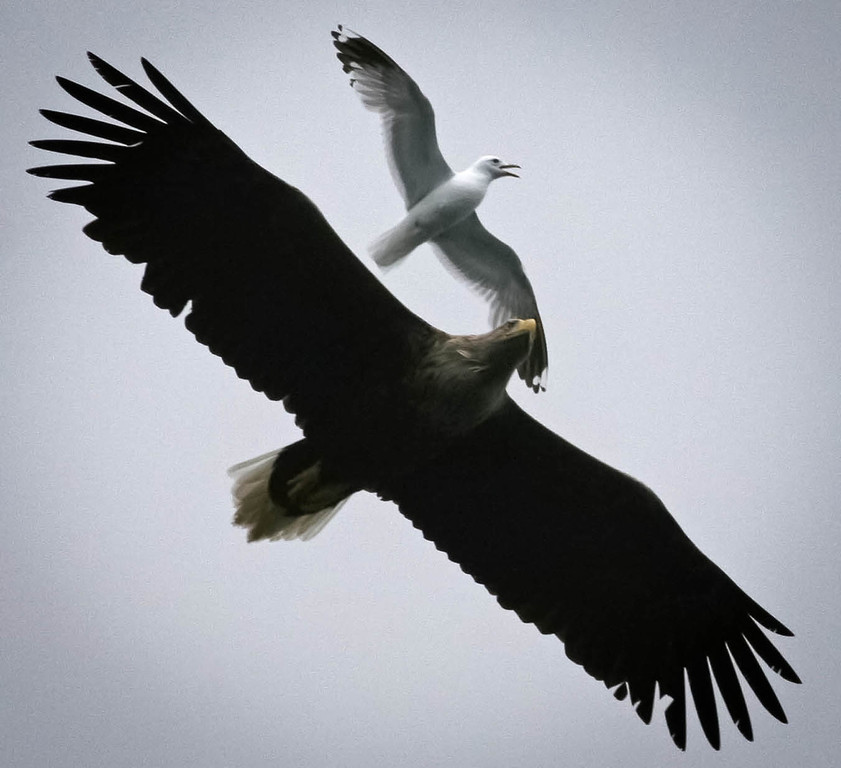About a year ago Sarah and I watched a special on PBS about the sea eagles of Mull. The story profiled a native of the island, Gordon Buchanan, who had returned home after making a name for himself as a world-famous wildlife photographer. He felt it was time to showcase Mull’s wildlife, and most of the hour-long program focused on the white-tailed sea eagles.
At the time I hadn’t visited Mull yet, but the gorgeous photography and massive eagles – these guys can weigh up to 17 lbs. with an 8+ ft. wingspan – put the island square on my radar. As I planned my trip around some of Scotland’s Inner Hebrides this past summer, the Sea Eagles of Mull PBS special was on mental repeat.
When I arrived to Mull, I was thrilled to find out about Mull Eagle Watch, a partnership between several commissions including the Royal Society for the Protection of Birds (RSPB), which has a viewing station out in the wilds south of Tobermory. After speaking with Neil, my go-to guy at Holiday Mull & Iona, I had an appointment set up with RSPB officers to check out the station.
After taking in the coast on my drive south of Tobermory, I cut inland down a gravel track to a parking area where Debby Thorne, one of the RSPB officers manning the viewing station, met me. We drove the rest of the way in her jeep as short-lived rain showers blew over the hills.
The story of the white-tailed sea eagles on Mull is epic. For centuries the eagles were considered nuisances due to their penchant for flying off with small children (just kidding!). In truth, they were hunted and poisoned to extinction 70 years ago. Such cruelty cannot last, and it was just 40 years ago that interested parties worked to reintroduce the white-tailed sea eagle to its original stomping grounds.
It has taken decades to help the eagles reestablish a foothold on the island and in western Scotland. The RSPB brought young white-tailed eagles from Norway, one of their last sanctuaries, and hoped to kick-start the population. While these eagles lived, they were unable to start a new colony, and so the RSPB worked tirelessly decade after decade until, finally, today, visitors to Mull can look skyward and see the majestic sea eagles soaring on the winds.
Debby showed me around the small and tidy viewing station with its overlook taking in a small loch and high pine forest. Earlier in the day a busload of kids had spotted two sea eagles here, and one of them even flew right over the viewing station. Rare, very rare Debby said with a smile.
I scanned the sky for a good hour while we discussed the mating habits of the eagles. The average lifespan of these great birds is around 20 years and they usually spend most of their life with one mate. Some birds can live to 25 years old! A recent blog post by David Sexton, the head RSPB officer in the region, detailed the long lineage of sea eagles that have lived on Mull since their reintroduction. He recalled a tale of an eagle couple that had been together 16 years when the female went missing one day. The male waited for weeks and months for his mate to return, looking for his lolaire sùil na grèine – the eagle with the sunlit eye. She never returned.
It must be heartbreakingly easy to get attached to these birds when they form such a core part of your life. Hell, I fell for them in an hour. Most of the eagles are tagged with satellite transmitters, and you can follow their movements on the Mull Eagle Watch site. Unfortunately for me, the sea eagles didn’t make an appearance while I was at the viewing station. But that’s part of the magic of wildlife, right? No guarantees, no promises. They have their own lives and if they let you in for a peek it’s all privilege.
Long live the sky kings of Mull.
Photos by Hilary Chambers via Flickr/Creative Commons

